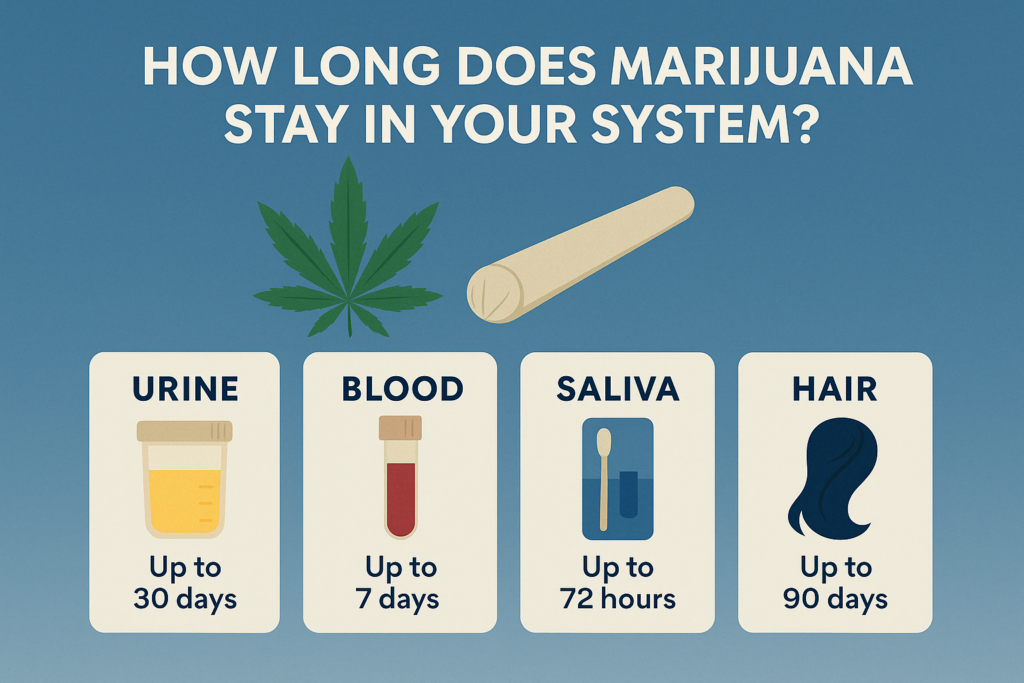Marijuana use has become increasingly prevalent, especially in areas like Orange County, where legalization has expanded access. However, many people still wonder, “How long does marijuana stay in your system?”
Whether you’re facing employment drug testing, navigating legal matters, or considering treatment in Huntington Beach, understanding the THC detection timeline is essential. In this article, we’ll explore the different marijuana testing methods, factors that affect detection, and what to expect if you’re quitting cannabis.
⚠️ Need support with cannabis use or testing concerns? Pacific Breeze Recovery offers compassionate care in Southern California.
Understanding THC and Its Effects on the Body
Tetrahydrocannabinol (THC) is the psychoactive compound in marijuana responsible for the “high.” When THC enters your body, it interacts with the endocannabinoid system, affecting mood, memory, appetite, and more.
Short-term effects of marijuana include:
- Euphoria or relaxation
- Altered sensory perception
- Impaired coordination and memory
Long-term or frequent use, however, can impact mental health and cognitive function, especially in adolescents or individuals with underlying psychological conditions.
👉 Concerned about your relationship with cannabis? Explore our Dual Diagnosis Program for support with co-occurring disorders.
Marijuana Detection Methods Explained
When it comes to drug testing, not all methods are created equal. Here’s an overview of the four primary ways THC is detected:
1. Urine Tests: The Most Commonly Used Method
Urine tests are most widely used in workplaces and rehab settings because they’re non-invasive and cost-effective. They detect THC metabolites, not the active compound itself.
Detection times:
- Occasional use: 1–3 days
- Moderate use: 7–21 days
- Chronic use: 30+ days
👉 Need a medically supervised detox? Learn about our Detox Program designed for safe and supportive cannabis cessation.
2. Blood Tests: Accurate but Short-Lived Results
Blood tests are used for more immediate detection, such as in accident investigations or DUI cases.
Detection time:
- Occasional use: 1–2 days
- Chronic use: up to 7 days
However, since THC is rapidly metabolized, this method is best for detecting very recent use.
3. Saliva Tests: Immediate Detection with Limited Window
Saliva tests are becoming popular for roadside drug checks due to their convenience.
Detection time:
- Up to 24–72 hours depending on frequency of use
These tests are quick but may not always detect long-term or delayed cannabis use.
4. Hair Tests: Long-Term Detection but Less Commonly Used
Hair follicle testing offers the longest detection window.
Detection time:
- Up to 90 days
However, hair tests are expensive, less accurate for recent use, and typically used in forensic or long-term monitoring situations.
Factors That Influence How Long Marijuana Stays in Your System
Several variables affect THC detection duration, including:
- Frequency of use: More use = longer detection
- Body composition: THC is stored in fat cells
- Metabolism rate: Faster metabolism = shorter detection
- Hydration levels: Dehydration may concentrate metabolites
At Pacific Breeze Recovery, we assess your unique history and health profile to tailor a detox and recovery plan that works for your body.
💬 Talk to an Admissions Specialist Today for personalized support and next steps.
General Timeline Summary for THC Detection by Method
| Test Type | Occasional Use | Regular Use | Chronic Use |
|---|---|---|---|
| Urine | 1–3 days | 7–21 days | 30+ days |
| Blood | 1–2 days | 2–7 days | up to 7 days |
| Saliva | up to 24 hours | up to 48 hours | up to 72 hours |
| Hair | up to 90 days | up to 90 days | up to 90 days |
These numbers represent averages and may vary depending on the individual’s physiology and usage patterns.
Quitting Marijuana: How Long Until It’s Out Of Your System?
If you’ve stopped using marijuana and are wondering when your system will be clear, the timeline depends largely on:
- Your prior frequency of use
- Your metabolic rate
- Your body fat percentage
- Lifestyle habits (exercise, diet, hydration)
For most people, urine tests become clean within 3–30 days. However, symptoms of marijuana withdrawal (such as irritability, insomnia, and cravings) may linger.
👉 Our team can help you navigate this transition. Discover our Individual and Group Therapy options.
Implications in Real Life: What You Need to Know in Orange County
Though cannabis is legal for recreational use in California, drug testing policies still apply in many workplace and legal settings.
According to California law (AB 2188), employers can no longer discriminate based on off-duty use of marijuana—but exceptions exist, especially for:
- Safety-sensitive positions
- Federal jobs
- Roles governed by DOT regulations
Therefore, understanding THC detection timelines remains essential for job seekers, employees, and anyone navigating the Orange County job market or legal system.
Pacific Breeze Recovery Can Help You Move Forward
If marijuana use has become more than just recreational—or you’re struggling with dependency and want to reset your life—Pacific Breeze Recovery in Huntington Beach is here for you.
We provide:
✅ Comprehensive detox and stabilization
✅ Therapeutic counseling & relapse prevention
✅ Holistic therapies including art, music, and equine therapy
✅ Medication-assisted treatment, if appropriate
✅ Support for co-occurring mental health conditions
🌊 Take the first step today.
📞 Contact our admissions team or call us to learn how we can support your healing journey in Orange County.
Understanding how long marijuana stays in your system is more than a scientific curiosity—it’s a key part of responsible cannabis use, job readiness, legal preparedness, and recovery.
By learning about THC detection timelines, recognizing the factors that affect elimination, and knowing when to seek help, you empower yourself or a loved one to make smarter, safer decisions.
If you’re ready to take that next step toward wellness, we’re here to walk it with you.
👉 Explore Programs at Pacific Breeze Recovery
References:





